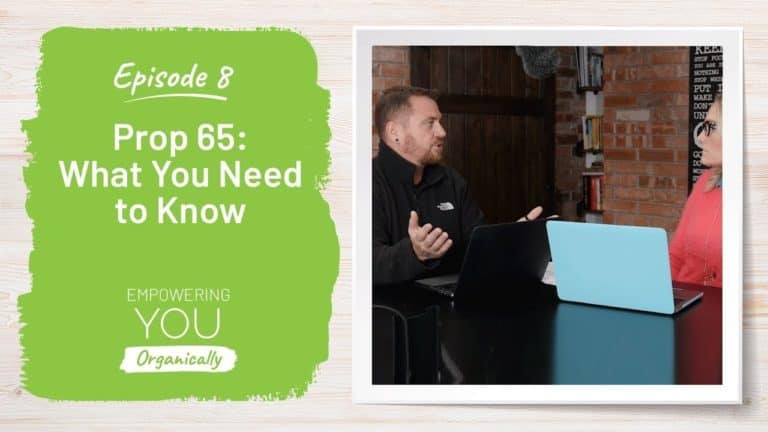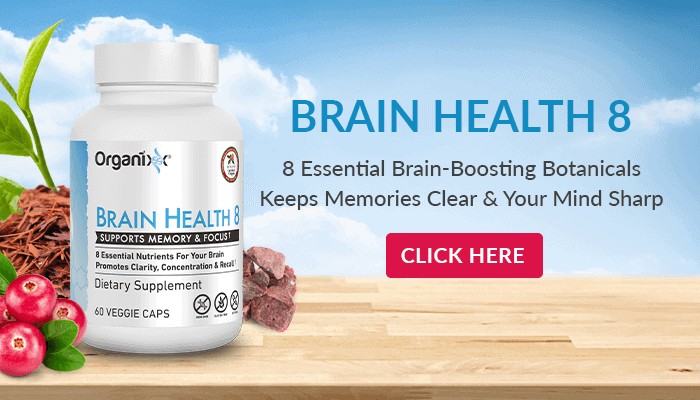Empowering you Organically – Season 1 – Episode 8
Title: Prop 65: What You Need To Know
Hosts: Jonathan Hunsaker & TeriAnn Trevenen
What is Prop 65?
Proposition 65 (Prop 65) (formally titled The Safe Drinking Water and Toxic Enforcement Act of 1986) is a California law passed by direct voter initiative in 1986 by a 63%–37% vote. Its goals are to protect drinking water sources from toxic substances that may cause cancer and birth defects and to reduce or eliminate exposures to those chemicals generally, for example in consumer products, by requiring warnings in advance of those exposures.
How does it affect Organixx?
Prop 65 mandates that foods, dietary supplements, and other consumer products bear warnings about cancer and birth defects if the product may cause exposures to certain substances, even at very low levels.
Prop 65 versus National & International Standards
U.S. Food and Drug Administration – FDA regulates both finished dietary supplement products and dietary ingredients. FDA regulates dietary supplements under a different set of regulations than those covering conventional food and drug products. More specifically, they are regulating dietary ingredients such as vitamins, mineral, herbs, or other botanical and amino acids, dietary substances for use by man to supplement the diet by increasing the total dietary intake or concentrate metabolite, constituent extract or combination the preceding substances.
- FDA claims 75 micrograms is safe for an adult. For pregnant women 25 micrograms, and for children, 6 micrograms
The European Food Safety Authority states, “Food is essential to life. EFSA’s scientific advice helps to protect consumers, animals and the environment from food-related risks.”
EFSA receives requests for scientific advice mainly from the European Commission, but also from the European Parliament or Member States. Upon receipt of a request, EFSA considers its contents, discusses it with the Commission and addresses any issues that need clarifying, such as the feasibility of the deadline. Following these discussions, EFSA and the Commission agree on a mandate, which includes the final terms of reference and a mutually agreed deadline. For market applications, EFSA validates/checks the completeness of the application and may request more scientific information from the applicant.
- The European Food Safety Authority estimates the average adult consumes around 50 micrograms per day.
Environmental Protection Agency (US) – According to the EPA, natural levels of lead and soil can range from 50 parts per million to 400 parts per million. When you count for the amount of lead in the soil from man-made pollution, some areas can contain up to 10,000 parts per million. Granted, these are contaminated areas, usually near factories. Proposition 65 (US) – A California law governing products sold in the state.
- Allows only 0.5 micrograms as the safe limit. And let’s put that into a little perspective here. If you just step outside in Los Angeles and breathe the air, or test the air, it would fail Prop 65 lead limit of 0.5 micrograms.
Examples of naturally occurring lead levels
Some of the following natural foods are 7-8 times the limit of what Prop 65 determines is safe, and these are naturally occurring. Because it is a whole food, it is not required to have a sticker. If it is an ingredient in a processed food then that food would require a sticker.
- Raw Avocado has 4.5 micrograms of lead
- Honey has 4.5 micrograms, of lead
- Raw Watermelon has 4.5 micrograms of lead
- Dried Raisins have 3.5 micrograms of lead
- Raw Cucumber has 3.4 micrograms of lead
- Raw Peach has 3.4 micrograms of lead
- Raw Red Apple has 2.6 micrograms of lead
- Dry Red Wine has 6.8 micrograms of lead
- Boiled Spinach has 7 micrograms of lead
- Fried Beef Liver has 9 micrograms of lead
- Italian salad dressing has 12.2 micrograms of lead
Understanding the Chemistry
Example: A company called Redmond products such as salt, clay, some powders with peppermint, charcoal, just naturally occurring things like cinnamon.
From their website, “Lead is a natural part of our planet in sea water, fresh water, and soil, and even in air. Every time you take a walk along a beach or breathe fresh mountain air, you are being exposed to the tiniest amount of lead, 50 to 400 parts per million of the surface of our planet, according to the EPA. Should we be worried? Trace amounts of lead might sound like a very bad thing, but the FDA has determined that consuming less than 75 micrograms of lead does not lead to health complications.”
“The really good news is that, on a chemical level, lead likes to make friends. Nearly all the lead in our environment is bound to other elements like zinc, copper, silver, and others.”
“There’s a trace amount of lead that bonded long ago with clay molecules and other trace elements. That bond prevents lead from accumulating in our bodies.”
“Why does a bond matter? Natural chemistry is pretty amazing. Each cell in our bodies depends on a specific compound to stay alive, one part sodium and one part chloride. Potentially deadly by themselves, these ions combined to create sodium chloride or salt, without which we couldn’t survive. Similarly, lead by itself is very different from lead that has already bonded to other elements or molecules.”
“Ingesting lead that isn’t bonded is dangerous for the same rare reason. Ingesting already bonded lead isn’t; the bond is really hard to break. The nature of Bentonite clay,” which is a product they sell, “means any lead is already bonded, which is why the FDA agrees it’s unlikely that any lead in Bentonite clay would remain in the body if ingested.”
“The existing molecular bond remains in place in any lettuce flushed from your system, along with other toxins that bond to neighboring clay molecules. Summary, if chemistry was never your thing, here’s the big picture. Tiny amounts of lead are in our planet’s water, soil, and air. Lone lead molecules pose health risks when bonded with other elements and compounds. The bond is too strong for our bodies to break. Any bonded lead leaves the natural way still bound to the same molecules as when we ingested it.”
What does this mean for whole-food-based supplements?
A whole-food based supplement rarely meets the Prop 65 standards since whole food ingredients, in their natural form, contain higher levels than allowed in Prop 65.
Why no sticker on some brands’ bottles?
Oftentimes companies may not be abiding by the Prop 65 mandate for various reasons.
Savvy Consumer Tips
- If you get a product that has a Prop 65 sticker, reach out to that company and ask them “Why? What is it that failed, and can you please put it in context? What were your test results? What’s the Prop 65 limit? What’s the FDA limit, and what were your test results?” And then make a decision for yourself.
- Know that some companies would rather run the risk of lawsuits for non-compliance than place a sticker on their product.
- Know the Prop 65 limits.
- Know the FDA limits.
- Ask for testing results if available.
* * *
Subscribe to Empowering You Organically
Never miss an episode!
APPLE PODCASTS SPOTIFY GOOGLE PODCASTS
–
Episode 8 – Prop 65: What You Need To Know





